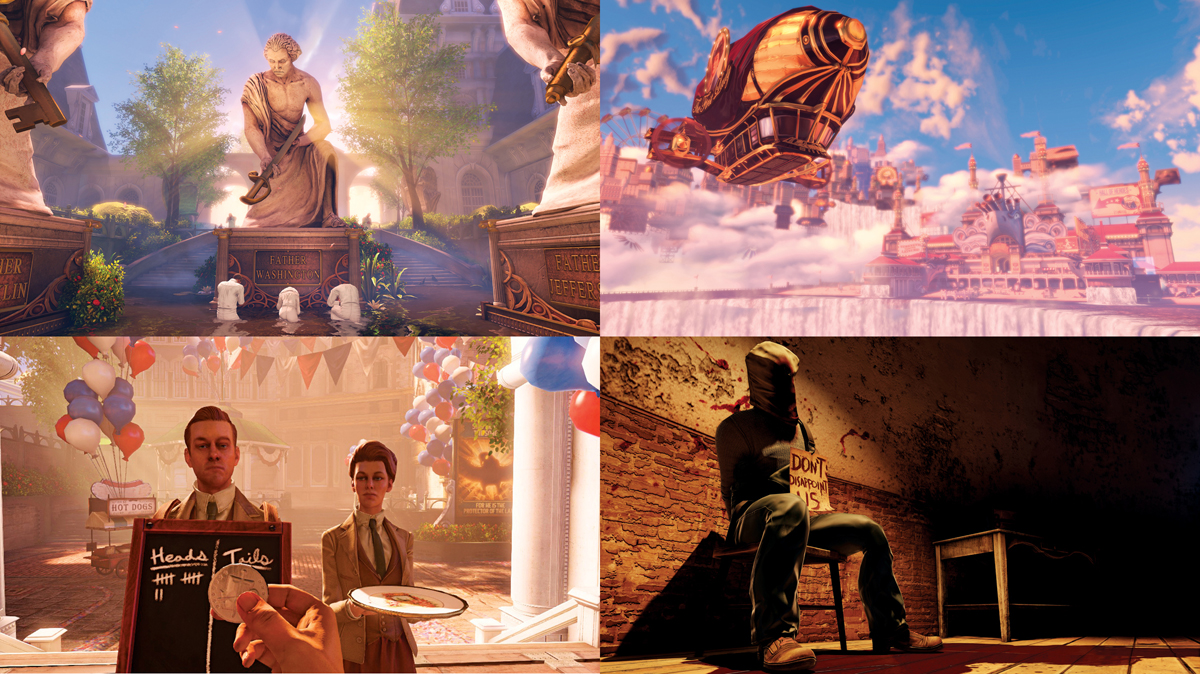Game Changer: Kevin Levine

Screengrabs via Irrational Games
Midway through BioShock—the video game Ken Levine wrote, the one that made his name famous—there is a moment when you, the player, are offered the option of killing a child. The girl, bony and hollow-eyed, cowers before you. If you let her live, the game will go on, but if you kill her, the game rewards you with increased strength. Either choice will have ramifications further down the line, but you can’t know this now. The child squirms to escape your grasp. You have to make your choice.
When BioShock came out in 2007, it was a milestone in the nascent industry of narrative gaming. It was one of the first games to offer the player a moral choice—a forking path between good and evil. Gamers went wild over its ambiguity, its storytelling, and its graphic beauty. “It’s no longer just another shooter wrapped up in a pretty game engine,” one reviewer wrote, “but a story that exists and unfolds inside the most convincing and elaborate and artistic game world ever conceived.”
“Seriously,” the reviewer went on, “if you don’t find something to love about BioShock, we’d recommend a trip to the nearest doctor to check if your heart’s still beating.”
The game has sold more than four million copies. Levine—at age 41, a failed screenwriter who had struggled for years to find an artistic niche—became a god among gamers. “Levine is known in his industry as a mad genius, a man whose games take five or six years to make, burn out staffers along the way and end up blowing players’ minds,” the Los Angeles Times wrote of him recently. In a field that requires intense collaboration among large teams of coders, artists, and designers, Levine has a reputation as an auteur, a stickler whose games are an expression of his own singular vision.
Last spring Levine’s Quincy-based studio, Irrational Games, finally unveiled his follow-up to BioShock, six years in the making. Like the original, BioShock Infinite takes place in a dystopian environment in which the player must choose between extremes of morality. And like the original, Infinite was a huge success: By July four million copies had been sold worldwide. “BioShock Infinite aims so damn high,” wrote IGN in its review, “that it’s a wonder it successfully hits any of its lofty goals at all. But it does hit them, again and again.”
Levine believes that only video games can allow the consumer to feel what it’s like to live with an objectionable set of values, or to act ignobly. In an age of violence up close, of bombings and schoolhouse rampages, he thinks games must present the imagery that the media fail to deliver. “One of the responsibilities of art is to actually show this is what it looks like when someone gets shot, because it’s really obfuscated” in news reports of war and violence, Levine said. “War is about sending pieces of metal very fast at people and tearing them to bits on the most primal level.”
Violence has always been a given in the genre of first-person shooters, the kind of game Levine writes. When BioShock came out, few questioned that. But this time around, in Infinite’s wake, some gamers are saying games should do more than just perfect the look of blood and wounds, do more than make the killing authentic. Games, they argue, can be more than even Ken Levine thinks they can be.

The Dungeon Master: Ken Levine has been hailed as a video-game auteur. (Photograph via Irrational Games)
Even today, at the age of 47, Levine calls himself a nerd. His default tendency in an interview is toward self-deprecation, again and again—“I was a B student,” he’ll say at one point, and then at another point, “I had no friends.” His origin story contains the standard sad-geek details—an isolated, bookish childhood, complete with a stigmatizing speech impediment—with an extra dollop of pathos: Lots of geeks played Dungeons & Dragons, the seminal tabletop role-playing game, but only Levine cops to having played it alone.
Playing D & D alone is like writing a play; there are many characters, but they’re all controlled by you. So it seems natural that Levine majored in drama at Vassar College, where he began writing and producing plays on campus. After school he went out to Los Angeles with screenwriting dreams. There he struggled for five long years. He got some work; one project he worked on was a vehicle for the Christian rock singer Amy Grant, a story about the devil falling in love with her. “I did not demonstrate a path to success with that story,” Levine said. “I was a decent writer. You’re either born with that or you’re not. But I knew nothing about storytelling.” Levine took one last shot at screenwriting with an idea about a society of vampires who swear off violence. “It was totally ahead of its time, and people were like, ‘What the fuck is this?’” he recalled. “I figured it was the best I could do, and I couldn’t get any motion on it. That’s when I gave up.”
He had been making ends meet by working as a computer consultant, so in 1995, Levine answered a job ad in a gaming magazine. He got the gig: game designer at a small studio in Boston called Looking Glass Studios.
Looking Glass was a lot of things to its industry: a clubhouse, in spirit and energy; a place of almost mythic imagination; a place that never made money. Some of the industry’s most respected designers got their start at Looking Glass, many from MIT. “Looking Glass was very much a dream job for me,” said Jon Chey, one of Levine’s colleagues there. “It was an odd organizational structure, a lot of decisions being made by people making the games, a lot of late-night brainstorming sessions. ” Its cofounder, Paul Neurath, was looking to broaden games into a more emotional experience. “There’s an immersion to good media, be it books or film or games, that you get drawn into in a way that the world around you just disappears,” Neurath said. “We looked at game-play aspects—how a player engaged with the game and got drawn into the experience.”
For Levine, coming to Looking Glass—and to video-game design—was like a rebirth.
“I devoted my entire life to it,” Levine said. “I was 29 years old, and suddenly I had a second lease. Not everybody gets a second grab at the ring—I did, and I knew it was important. I started at $34,000, living in a Harvard Square apartment on Kirkland Street. I had no life, but I felt so lucky.”


